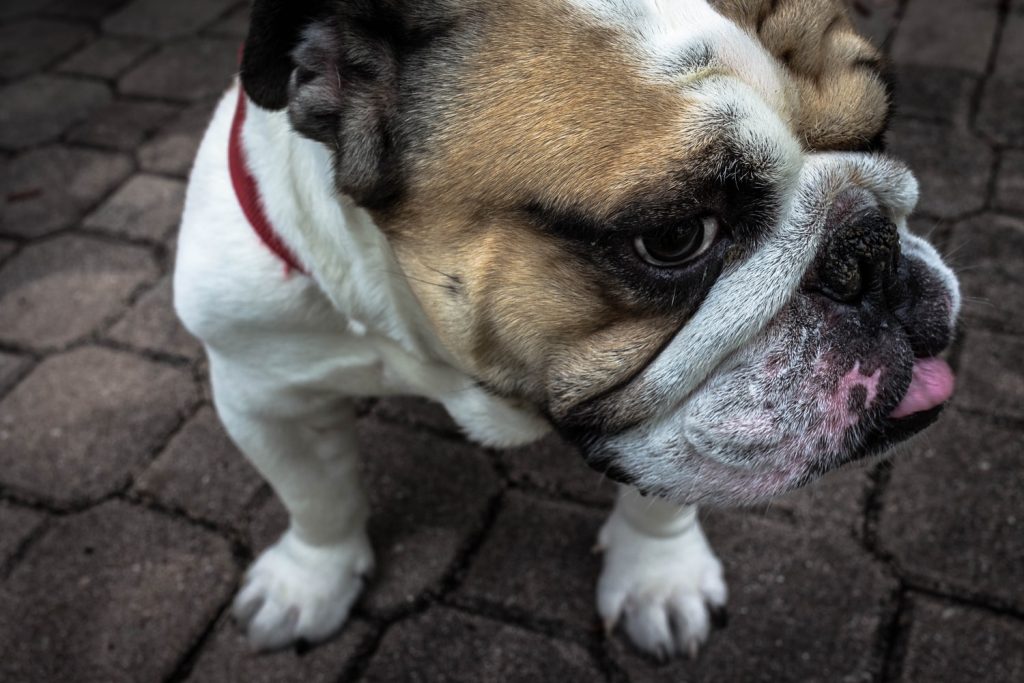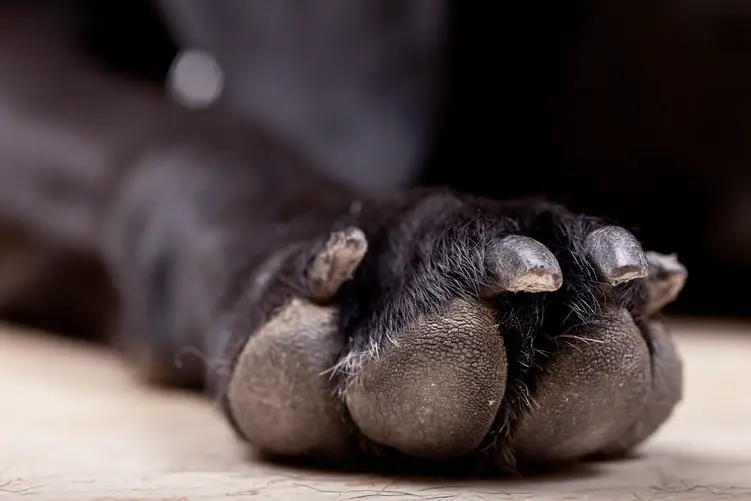Bulldog paws red and swollen is a common condition found in the breed. It is medically called pododermatitis. Simply put it means the swelling of the paw and pad. This condition unfortunately can become quite painful and even debilitating if neglected. So many diseases and disorders can trigger this kind of enlargement of the paw and pad.
There are various strategies and treatment plans, depending on what is the cause of the inflammation. Pododermatitis in Bulldogs is a common dermatologic problem and is usually linked to many underlying skin diseases. The most known conditions that progress to paw allergy in bulldogs are idiopathic sterile granulomas, demodicosis (red skin mite), allergic dermatitis (food allergies and atopic dermatitis), and skin-fold dermatitis.
These conditions all have the potential to develop into secondary yeast bacteria and yeast overgrowth dermatitis. Inflammation of the paws can be quite irritating and even painful for the Bulldog. As pododermatitis has many known causes, its treatment looks into the underlying causes of the swollen feet.
Bulldog Paws Red and Swollen Causes
Inflammation of the paws can be caused by a multitude of reasons. Several different circumstances can lead to their enlargement. These may include:
Bacterial and Fungal Infections
This kind of disorder often manifests with feet that are inflamed, itchy, and often with a foul odor. If your dog’s paws smell funky and have brown or yellow puss, then it has surely caught an infection. Your veterinarian will extract a swab and subject it to laboratory testing. This will determine if your dog has either a fungal or bacterial infection. Expect a course of topical creams and/or oral antibiotics as the curative course.
Allergies
Allergies of many kinds whether triggered by food, the environment or physical contact, tend to show up on the skin for Bulldogs. One of the initial spots they can affect is the dog’s paws. Your dog could also be allergic to an unknown ingredient from its food. Ask your vet and tell him your dog’s diet. Is it rich in carbohydrates? Protein?
These are just a few of the reasons why your Bulldog has red and swollen paws. Furthermore, a dog can itch elsewhere on its body that may not be too noticeable, so take note of its overall behavior. An allergic reaction might be ongoing, but you fail to notice it.
Environment

Dogs may also get their feet inflamed by stepping on the scorching pavement, through injury, or by stings and/or bites from critters. Bulldogs can manifest paw allergy if they walk on a surface that triggers the infection. It could likewise be house-cleaning agents for floor maintenance, dust, or seasonal pollen in the grass. Try to be observant of your pet’s body language to determine the trigger.
Immune-Mediated Disorders
The immune-mediated disease is a disorder of unknown cause. Autoimmune disorders like Pemphigus Foliaceous can cause painful hyperkeratosis (a thickening of the outer layer of the skin) of the pad of the paw. This type of swelling condition has the dog developing scabs, lesions, and sometimes blisters to all four paws. Thickening of the paw pads and darkening also occurs.
Tumors
In some instances, the inflammation may be caused by a tumor or tumors growing on the Bulldog’s paw or paws. if this is the case the tumor should be surgically removed if necessary. Your veterinarian may also order a biopsy. This will determine if the tumor is benign or malignant (and hopefully it is benign).
Interdigital Cysts
Interdigital cysts are also prevalent among members of the bulldog breed. It easy to recognize them. They appear as soft-to-firm fluid-filled bumps that grow in the skin web between the Bulldog’s toes. These bumps can break open, discharging pus.
Interdigital cysts could be due to underlying bone conditions. To ascertain this, a biopsy will be recommended, to rule out the presence of cancer.
These cysts are growths between the toes and could also be the culprit for red and swollen paws. There is no common consensus as to what causes them. Some believe it is an allergic reaction or a fungus, while others think it is an ingrown hair.
Symptoms of Pododermatitis
First of all, keep an eye for indications such as pigmentation of skin as well as the hair between the dog’s toes. The hair could be black, brown, or red. Other symptoms are soft-to-firm swellings in the skin web between scabs, toes, and a discharge of pus or fluid. Also, look out for blisters and nodules on the paws, loss of the upper layer of the skin of the foot, or thinning of hair on the paws.
You might likewise observe that your dog is biting or licking the skin between its toes. If you observe any of these signs, it is wise to take your Bulldog to the veterinarian’s clinic for a check-up.
Once again, common signs and symptoms are:
Pigmentation of the hair and skin
Red, pink, or brown inflammation between the toes
Red, brown, and black between the toes
More mouthing of the feet in between the toes
Discharge of pus and fluid
Treatment of Red and Swollen Paws in Bulldogs
The way pododermatitis is treated will depend on the underlying disease or disorder that is causing pain and inflammation. If the cause is linked to any kind of substance, such as floor surface or cleaning agent, the treatment is simple. The paws should be thoroughly sterilized and cleaned. Medications like a course of antibiotics or antifungals may also be prescribed to counteract fungal or bacterial infections.
Medicinal Treatment
When antibiotics alone do not get the swelling under control, other medications are tried for 6-8 weeks. It is observed in this window if the feet then heal and get better. A vet will also order a test of the thyroid levels to make sure that the cause is not an underlying problem. If there is an underlying cause, it needs to be identified and treated, or else the paws will not heal by themselves.
Fungal infections will need medication for at least 6 months. Furthermore, bear in mind that the removal of the infected toenails may be the only option for completely healing your dog from the problem. You will have to inspect the toe every day and clean it of any debris. Use baby wipes to clean between the toes and then follow it with a dry cloth to keep the toes dry.
Anti-inflammatories and corticosteroids or could also be employed either intravenously or orally to bring down swelling and inflammation. Medications may also be introduced to adjust for imbalances in the dog’s blood chemistry. Surgery is also an option with dogs that have tumors or pustules on their paws.
Treatment of Interdigital Cysts
In case the area with Interdigital cysts has not been infected, try an Epsom salt bath that should be employed only during the early stages. Do this as soon as you spot the cyst. Typically, this will help get rid of the cysts in a very short time. This procedure also makes the paws less painful. Immerse the swollen paws of your dog with Epsom salts 2 to 3 times a day.
Most of these strategies of treatment may take several days or even weeks. The objective is to eradicate the underlying illness. During this phase of treatment, the Bulldog may not want to stand or walk due to pain. Manage excessive discomfort in the feet by using topical anti-inflammatory and corticosteroid drugs.
It is imperative to stress that to follow a doctor’s instructions to the letter is crucial. All medications are administered in a specific manner so that drugs that are provided do not interfere with one another. This likewise ensures that no overdoses happen.
Treatment If Underlying Cause Is Allergy
If your Bulldog dog has a food allergy, the simplest way to deal with it is to exclude any chicken from its diet. Antibiotics and preservatives found in chicken find their way insidiously into your dog’s system through food. This can certainly trigger many dermatological issues for your dog. Instead, substitute chicken with bison, lamb, or fish-based food.
If an allergy is a cause, expect to see a marked improvement right away after changing your dog’s diet. You could see an improvement in a window of 2 to 7 days. Other related skin conditions typically recover after 2 weeks when you remove the allergen from the diet. As a rule, always go for dog food that is specifically made for Bulldogs.
Bulldogs are notorious for being hyper sensitive. The breed in general has a host of food allergies. Dog food makers know this and will formulate bulldog’s food minus the usual allergens.
Keep You Bulldog Indoors
Knowing full well that there are many hazards outdoors that exacerbate swollen paws, it is prudent to keep your Bulldog indoors. Do this at least until the signs of the swollen paws have ceased. Many triggers outdoors could make it difficult for you to manage this condition. For the meantime, keep that pooch away from harm, safely inside the house. It will also be much easier for you to maintain a cleaning routine for the dog if it is indoors temporarily.
Recovery of Swollen Paws

As dog owners, we are always very impatient when it comes to the recovery of our pets. It pains us to see them experiencing pain or discomfort. We are also very keen to observe if they are feeling under the weather. Bulldog owners can easily tell just at a glance if their pooch is feeling something awry.
The projection for recovery of Bulldogs that are suffering painful or inflamed paws will largely hinge on the success of treating the underlying cause. There are disorders manageable in a relatively short amount of time and without a great deal of effort. However, other situations may be more challenging and take weeks or even months.
To be safe, adopting extra support measures are wise while the paw is recovering. The dog’s paws can be quite prone to environmental hazards. To properly care for the healing paws, inspect them regularly. Cleaned, and moisturize often too. Therapy socks or shoes to protect a dog’s paws are also good to protect the healing process.
In Conclusion
We all desire that our Bulldogs are healthy and happy pets. Whenever we see them hurt, it is heartbreaking. What is the point if they cannot participate in the activities we enjoy? Knowing that Bulldogs are prone to paw swelling, we must be well-informed of the condition.
Device a cleaning routine so that you can thoroughly check in between the toes all the time. This way you can detect any swelling or cysts early on. Get a few steps ahead of these problems so your beloved Bulldog lives a happy and contented life.

